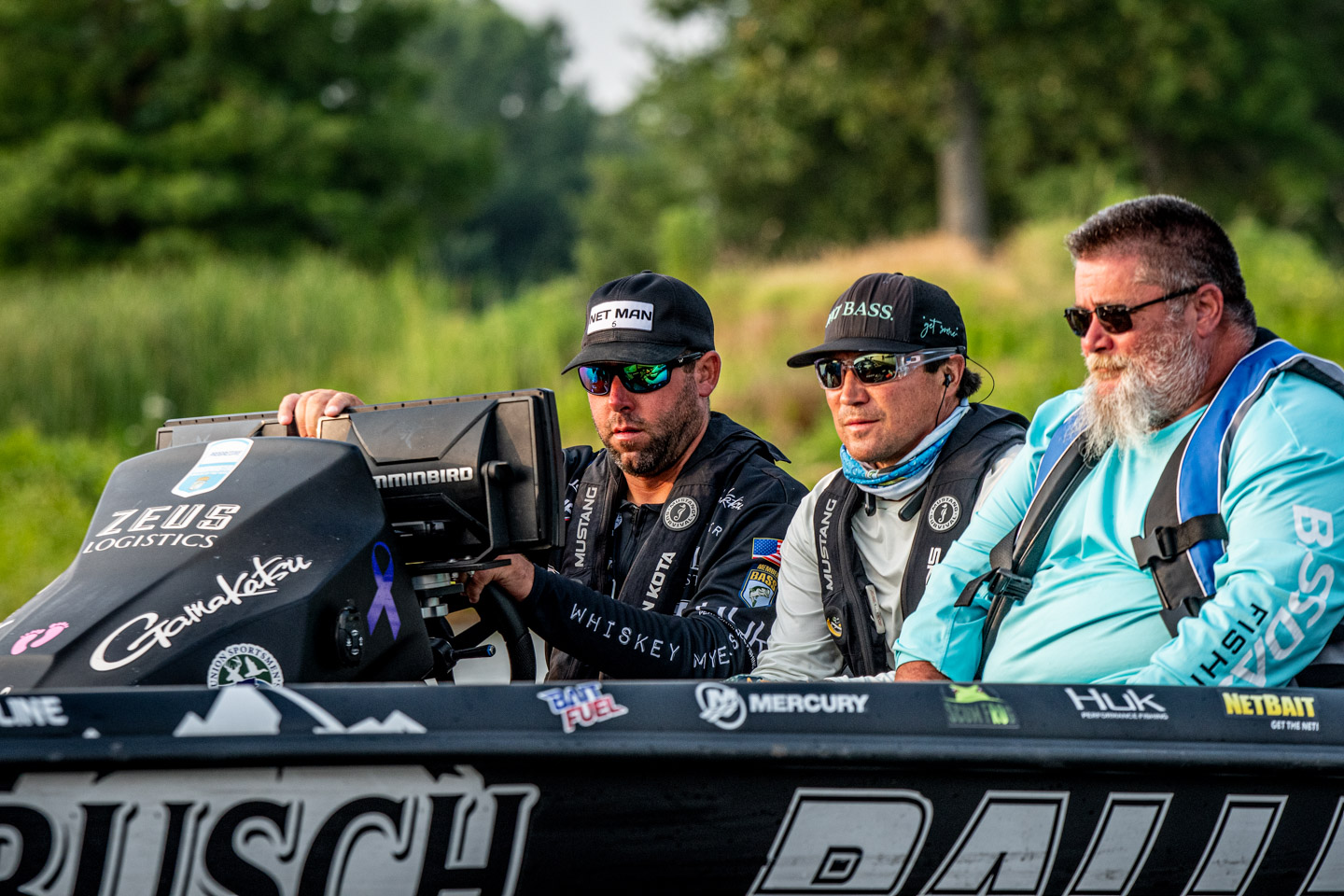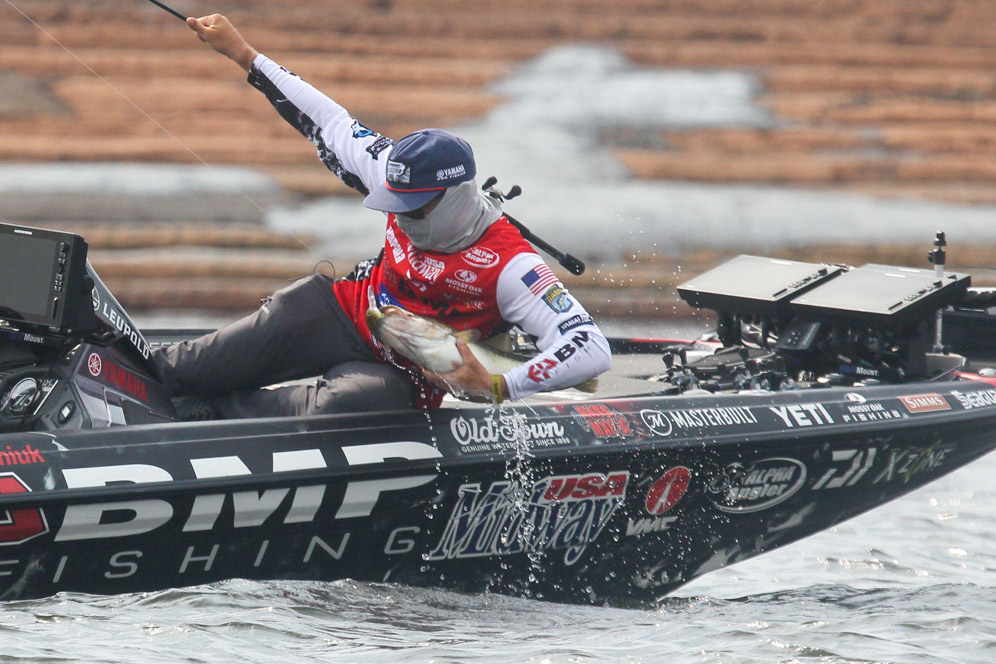
Efficiency — many ways to define that term, but during the Simms Bassmaster Elite at Lake Fork, some of the top finishers agreed that it came down to three critical points: Time-management, precision and consistency.
At the top of the leaderboard, winner Lee Livesay and runner-up Brandon Palaniuk agreed that Humminbird electronics and Minn Kota Ultrex trolling motors played invaluable roles in their success. For Livesay, his entire tournament week paralleled the One-Boat Network, which seamlessly integrates Humminbird and Minn Kota products.
Just as the OBN links his equipment from bow to stern, Livesay leveraged these technologies to carry his findings from the start of practice until the end of the tournament. Doing so yielded a winning total of 113 pounds, 11 ounces and his second Century Club Belt — awarded to anglers catching 100 pounds or more in a four-day event.
“In practice I relied on my console units — my Humminbird MEGA Side Imaging and Down Imaging — to find my schools of fish,” said Livesay, who also won the 2021 Lake Fork Elite. “I also used my LakeMaster mapping on some of the shallower stuff.
“I was looking at all kinds of offshore structure from shallow shell beds to bream beds, to the group I found on a high spot in the timber. I found different groups in practice and came back and fished them in the tournament.”
During competition days, Livesay relied on his Humminbird MEGA 360 to closely inspect his spots and determine the best approach, while Spot-Locking his Ultrex to hold in perfect position. Palaniuk described a similar strategy that was big on stealth.
“The biggest thing was using the LakeMaster charts and once I got dialed in to a depth zone, I would use my depth highlight and set it to a certain depth zone so I could detect subtle changes in the contour lines,” he said. “That allowed me to look at the lake differently and find some places that maybe weren’t getting as much pressure from the other anglers.
“When I actually identified those areas, then I would idle around and use my MEGA Side Imaging and MEGA Down Imaging to see if there were actually fish there, or what type of structure was there.”
Dealing with limitations
With Lake Fork about 5 1/2 feet low for dam repairs, Livesay and Palaniuk knew the shrunken playing field would bring greater fishing pressure and require more strategic searches. Palaniuk targeted modest points in 10 to 25 feet, while Livesay caught fish on deep points and an unassuming little high spot with hard bottom amid the timber.
“In my mind, I figured I would mainly be fishing offshore,” Livesay said. “With it being low I thought there would be more fish drawn out. It doesn’t get that low a lot, so I figured I was going to have to look at new water and figure out where these schools moved.”
Windy conditions also challenged anglers, not only in their navigational concerns, but in their ability to fish effectively. As Livesay notes, this is where Spot-Lock saved the day by allowing him to maintain the ideal position for each scenario.
“I was setting up either above the fish, or below them, and then I was using my Humminbird MEGA 360 to see the fish as they moved up to feed,” Livesay said. “The shallower the spot, the more I would want to get above it to be as quiet as I could be. Out in the deeper water I’d make long casts with the wind.
“Anything that was deeper, I’d get below it, especially if I was throwing a jig. If I Spot-Locked above them, I would use the rear view so I could see behind the boat. If I was below them, I’d use the front view of my 360.”
Watching the show
Livesay’s MEGA 360 proved particularly illuminating on his high spot in the timber. A textbook feeding station, this hard bottom area of about 40 by 40 feet saw fish coming and going as their appetites dictated.
“I could sit still with my Ultrex Spot-Locked and literally see those timber fish swimming back and forth from the trees, to the hard spot, to the trees,” Livesay said. “I would just watch those fish swim around on my 360, and I’d make pinpoint casts to them.”
As Livesay notes, success required specific casting angles, both for fish appeal and extraction. Fork’s standing timber is an unforgiving habitat and one he would not have been unable to fish without a wind-combatting, GPS trolling motor.
“I’d wait for my 360 to come around, and then I’d throw my jig or my worm or my crankbait over there,” Livesay said. “That Ultrex let me sit there quietly and get the right angles in the timber to give myself the best chance of getting the fish out.”

Finding the juice
Devoting his tournament to two main spots, Palaniuk said he had plenty of fish, but they never seemed to settle — likely a low-water impact. Thanks to his MEGA 360, he was able to keep tabs on their comings and goings.
“What the 360 allowed me to do was identify the key places where I continually saw those groups of fish show up and feed,” Palaniuk said. “That allowed me to say, ‘These groups of fish keep feeding in the same place,’ and when the wind would change direction, I was able to roll up on those places, change the boat position angle, but still be able to target those key areas.”
Noting that his main areas were about 50 by 50 yards, Palaniuk said the sweet spots were about the size of a bass boat. Sometimes it was a fallen tree laying on the bottom, a cluster of stumps or an area of harder bottom.
“When I’m fishing those places, I’m Spot-Locking them and I’m seeing how those fish are moving in and out and I’m seeing that structure they’re continually moving up on,” Palaniuk said. “If you’re just scanning around with MEGA Live or Side Imaging when the boat is moving, it’s really difficult to be able to process what you’re seeing.
“You see the fish moving on your MEGA Live, but understanding where they’re going to and where they’re coming from isn’t always as easy. But knowing where they were going to end up, I could line up my casts perfectly.”
Dialed in delivery
Each of Livesay’s catches directly correlated to his reliance on the One-Boat Network; however, Livesay recalls a solid example of how this technology impacted his event. On Day 2, he visited a spot he’d located in practice and made a key change that unleashed the potential.
“I had caught one 6-pounder there on Day 1 and that was it, but on Day 2, I switched from a 1/2-ounce 6th Sense Divine Hybrid Jig with a Netbait Paca Craw to a 6th Sense Crush 300DD crankbait just to see what was there,” Livesay said. “On my first cast, I caught one that got me hung up in a tree. I said, ‘Man, I don’t want to throw in there again, I’m going to get hung up again.’
“I looked at my Humminbird MEGA 360 to see where the underwater trees were located, and I rotated around to get the best angle I could to get around the tree from the backside. I Spot-Locked and made a cast and as soon as the crankbait hit the bottom I had one one.”
Sitting in perfect position, Livesay proceeded to catch 10 fish in 10 casts. His final fish of that flurry went 7-12.
“That was a perfect example of Spot-Locking on the exact cast,” Livesay said. “I used my 360 to see those trees and made a perfect little line in there.”
Putting it all together
Livesay lauded the way his Humminbird units, LakeMaster mapping and Minn Kota Ultrex allowed him to put all the puzzle pieces together: “They call it One-Boat Network for a reason; it all connected from practice to the end result. A lot of those schools, I didn’t fish in practice, but I trusted what I saw on my electronics and came back and fished them on my 360.
“I graphed some fish in the tournament too. I found a new school on the afternoon of the second day and came back on the third day when I needed a big one and caught an 8-pounder. Trusting your electronics, knowing what you’re seeing and coming back at the right time — that’s huge.”
Palaniuk agrees and points to the critical benefit of boat positioning.
“I was catching a lot of my fish on a crankbait, and I was able to line it up on my 360, have my boat facing into the wind and cast downwind to get more distance, which allowed my crankbait to stay in the strike zone a lot longer,” Palaniuk said. “If I didn’t have Spot-Lock, I’d be fighting the boat positioning, trying to keep it at that same angle where you can line up your cast on 360.
“It just makes it difficult, in that your body’s out of position because your legs are facing forward trying to run the trolling motor, but you’re trying to fish backward. Spot-Lock allows you to push a button and it removes that worry from the equation and allows you to focus on your cast and make that cast over and over again.”
Precision and consistency — repeating the same specific task is the recipe for success.
Palaniuk’s summation: “Overall it just makes you more efficient.”





